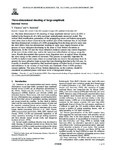Three-dimensional shoaling of large-amplitude internal waves
| dc.contributor.author | Vlasenko, Vasyl | |
| dc.contributor.author | Stashchuk, Nataliya | |
| dc.date.accessioned | 2015-11-28T18:10:57Z | |
| dc.date.available | 2015-11-28T18:10:57Z | |
| dc.date.issued | 2007-01-01 | |
| dc.identifier.issn | 0148-0227 | |
| dc.identifier.issn | 2169-9291 | |
| dc.identifier.other | C11018 | |
| dc.identifier.uri | http://hdl.handle.net/10026.1/3855 | |
| dc.description.abstract |
The three-dimensional (3-D) shoaling of large-amplitude internal waves (LAIW) is studied in the framework of a fully nonlinear nonhydrostatic numerical model. The vertical fluid stratification, parameters of the propagating waves and bottom topography were taken close to those observed in the northern part of the Andaman Sea. It was found that three-dimensional evolution of LAIWs propagating from the deep part of a basin onto the shelf differs from two-dimensional shoaling in many ways largely because of the process of wave refraction developing in the areas of local bottom elevations or depressions. In the 3-D case the wave refraction produces concave and convex fragments of the wave fronts which may lead to the transverse redistribution of energy along the wave. Results demonstrate that concave wave fragments work as optical lenses focusing the wave energy to the centers of curvature. This process is especially important for LAIWs in shallow water zones where wave amplitudes are close to the saturation level. In general, the wave refraction leads to more fast wave breaking than that in the 2-D case. As a results, it should be expected to find localized regions of higher levels of water mixing and turbulence in the vicinity of local banks and headlands where LAIWs produce concave patterns. The areas of local bottom depressions, on the contrary, should be considered as potential places with lower level of background mixing. Copyright 2007 by the American Geophysical Union. | |
| dc.format.extent | C11018- | |
| dc.language | en | |
| dc.language.iso | en | |
| dc.publisher | American Geophysical Union (AGU) | |
| dc.title | Three-dimensional shoaling of large-amplitude internal waves | |
| dc.type | journal-article | |
| dc.type | Journal Article | |
| plymouth.author-url | https://www.webofscience.com/api/gateway?GWVersion=2&SrcApp=PARTNER_APP&SrcAuth=LinksAMR&KeyUT=WOS:000251347200001&DestLinkType=FullRecord&DestApp=ALL_WOS&UsrCustomerID=11bb513d99f797142bcfeffcc58ea008 | |
| plymouth.issue | C11 | |
| plymouth.volume | 112 | |
| plymouth.publication-status | Published online | |
| plymouth.journal | Journal of Geophysical Research-Oceans | |
| dc.identifier.doi | 10.1029/2007jc004107 | |
| plymouth.organisational-group | /Plymouth | |
| plymouth.organisational-group | /Plymouth/Faculty of Science and Engineering | |
| plymouth.organisational-group | /Plymouth/Faculty of Science and Engineering/School of Biological and Marine Sciences | |
| plymouth.organisational-group | /Plymouth/REF 2021 Researchers by UoA | |
| plymouth.organisational-group | /Plymouth/REF 2021 Researchers by UoA/UoA07 Earth Systems and Environmental Sciences | |
| plymouth.organisational-group | /Plymouth/Research Groups | |
| plymouth.organisational-group | /Plymouth/Research Groups/Marine Institute | |
| plymouth.organisational-group | /Plymouth/Users by role | |
| plymouth.organisational-group | /Plymouth/Users by role/Academics | |
| dc.identifier.eissn | 2169-9291 | |
| dc.rights.embargoperiod | Not known | |
| rioxxterms.versionofrecord | 10.1029/2007jc004107 | |
| rioxxterms.licenseref.uri | http://www.rioxx.net/licenses/all-rights-reserved | |
| rioxxterms.type | Journal Article/Review |


